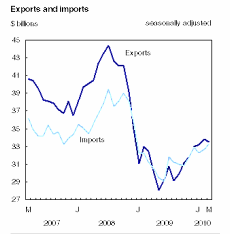

Canada’s merchandise imports increased to $33.3 billion in March, up two percent from $32.6 billion in February. According to Statistics Canada, import volumes were up 3.5 percent, which offset a 1.5 percent dip in prices.
At the same time, exports decreased 0.7 percent, from $33.8 billion in February to $33.5 billion. A 2.9 percent drop in export prices eclipsed a 2.3 percent bump in volumes. This marks the first time exports declined in six months.
Despite the drop in exports, Canada managed to maintain its trade surplus with the rest of the world, but the gap is narrowing from $1.2 billion in February to $254 million in March.

According to TD Economist Francis Fong, March’s data came in “well below market expectations” of a 1.6 billion surplus, which is likely a reflection of the relative domestic strength of the Canadian economy and the strong Canadian dollar.
“Though the trade sector has recovered rapidly since the economy exited from recession in the third calendar quarter of 2009, it was also one of the hardest hit and so has a long way to go before both exports and imports return to their pre-recession levels,” commented Fong.
“Nominal exports fell by more than one-third at the height of the downturn while imports fell by more than a quarter. Thus far, imports have regained more ground than exports have due to the stronger position of the Canadian economy relative to the rest of the world, but even then have only recovered about two-fifths of the losses. Exports have even further to go, so far only recovering about one-third of its losses.”
Imports
Precious metals were the main driver of the increase in imports in March. Imports of metals and metal ores grew 21.2 percent, and precious metals hit a record high of $1 billion. Overall, imports in the industrial goods and materials category rose 10.4 percent.
Imports of energy products halted two months of decline by growing 10.1 percent.
Automotive imports fell 5.8 percent, prompted by a 13.3 percent drop in passenger autos.
Imports of other consumer goods declined 2.3 percent to $4.6 billion—the lowest level since April 2008.
Exports
A 6.6 percent drop in exports of energy products—particularly petroleum and coal—was a main contributor to the overall export decline.
Exports of machinery and equipment fell 1.9 percent.
By contrast, exports of industrial goods and materials rose 4.7 percent—the third consecutive monthly gain. In this category, exports of precious metals were particularly strong, increasing 47 percent month-over-month.
Forestry product exporters recorded their seventh consecutive monthly gain, with exports increasing three percent.
By region
With the US, exports and imports both fell in March—exports by 2.5 percent, imports by 0.6 percent. As a result, Canada’s trade surplus with the US narrowed to $3.8 billion in March from $4.3 billion in February.
The story was different with the rest of the world. Exports to non-US countries grew 4.2 percent—the third consecutive gain. Imports rose 6.5 percent, an uptick caused largely by a 19.4 percent spike in imports with the European Union. Because of that, Canada’s trade deficit with non-US countries widened, from $3.2 billion in February to $3.6 billion in March.
Advertisement

